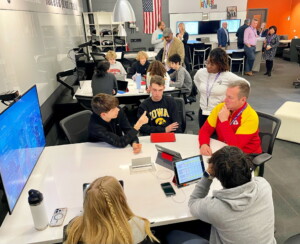What You’ll See More of 2013

A reporter asked me what to expect on the education front in 2013. To some extent you’ll see an extension of the blog ” 5 Megatrends That Shaped 2012 Education.” But like MOOCs in 2012, there are likely to be a few breakout trends that few predicted. Here’s our best take on eight trends to watch:
1. More iPads. In the last week I’ve meet with hundreds of superintendents and school board members and about 40 percent of them were taking notes on iPads and said their district had made or was planning iPad purchases. I’m all for 1:1 environments, but this overheated trend is ahead of broadband, management apps, and staff development. Like Bob Wise says, “Stop and build a plan.”
2. More blends. A couple dozen interesting K-12 next-gen models will open in September as will hundreds of school district adaptations of existing blended learning models.
Cost pressure and engagement expectations will also result in most colleges advertising blended learning feature next year.
3. More unbundling. There will be further evidence of a slow unbundling of the attendance boundary one-size-fits-some model with self blending and choice to the course initiatives (see Louisiana Course Choice, Utah’s Statewide Online Education Program).
In higher ed, students are collecting credits from a variety of sources: credits earned in high school (see College Board Improves AP Exams) , competency-based credits (see Free College Courses, Cheap Credits, Flexible Pathways) , and online learning.
4. More online learning. It’s possible that K-12 online learning will double in 2013 but it will be hard to measure because much of the growth will take place in school district programs. As recommended by Digital Learning Now! a handful of states will expand access to multiple providers and a few more will adopt choice to the course.
5. More playlists. It will be easier to turn grade level content collections from folks like Khan Academy, PowerMyLearning and GooruLearning into customized playlists.
6. More apps. “ There’s an app for that” will continue with more great apps for reading, writing, math, and special needs.
The addition of powerful apps will transform leading social learning platforms Edmodo into a learning platform ecosystem.
7. More competency-based programs. More challenging than the shift to digital is the shift from cohorts to competency. As discussed on CompetencyWorks and practiced most widely in Maine and New Hampshire, the practice of asking kids to show what they know will expand as the toolset to manage mastery-based matriculation matures. Watch Michigan’s improvement district, EAA, for an interesting growing blended and competency-based improvement initiative.
8. More data. It’s still top of the first inning for Big Data in learning. By this time next year there will be interesting early evidence of the benefits of comprehensive learner profiles from:
- Blended platforms like EdElements, Buzz, and Vschoolz
- Data shops like Junyo and Ontract
- Online learning providers like Connections and K12
- Adaptive instruction providers like Dreambox, CompassLearning, and Curriculum Associates; and
- Winners of the Race to the Top District program announced this month.
The use of learner profiles in higher ed will lag K-12, but building a profile including a planned path to graduation that an advisor and student could monitor would result in a big boost to college completion. Watch for developments in developmental education like an expansion of the Knewton-Pearson partnership.
Speaking of post-secondary developments to keep an eye on, watch for entrepreneurs (including a couple of community colleges) that createblended job prep that combine aspects of for-me and for-degree: interests and job requirements, JIT & cohorts, and online and hands-on. These job-ready personalized learning systems will have four elements:
- A map of the stuff you need to know and be able to do to get a job
- An assessment that produces an inventory of what you know and can do
- Map of your knowledge/skill gaps that powers an individual learning plan; and
- A variety of ways to learn what you need to learn.
That individual learning plan might look like series of recommended Udemy, P2PU, or edXcourses that add up to a certificate that, with a portfolio and some references, is better than most degrees as a market signaling device.
What won’t happen in 2013? We won’t see a slowdown of talent inflow and investment in edupreneurs. We also won’t see reauthorization of ESEA: it’s ridiculous, nearly criminal, but congress will fail to revise and renew federal education policy.
That’s what we will see in 2013. What did we miss?
This blog first appeared on EdWeek.






0 Comments
Leave a Comment
Your email address will not be published. All fields are required.